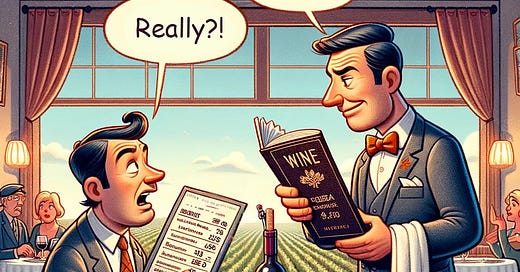NAPA VALLEY, Calif. — An imagined but plausible scenario:
A diner says to the waiter, “Is this wine really $80?"
Waiter: “Yes, that’s the price on the menu.”
Diner: “Tell you what, I’ll give you $55 for it.”
Waiter: “The price is not negotiable.”
Diner: “Your pricing doesn’t conform to current market conditions. I’m leaving. I’ll be back when your pricing is more realistic.”
This interaction, while fictional, is becoming a plausible reflection of today's wine market, characterized by an oversupply and prices that have soared beyond what many consumers are willing to pay.
The decline in wine sales is pervasive, challenged by an increasing array of non-alcoholic beverages and changing consumer behavior. Gone are the days of reasonable wine markup in many retail shops and restaurants, leaving a market now brimming with quality wines that are still overpriced. This shift comes as American wine consumption per capita has dipped to its lowest in two decades, signaling a significant change in consumer preferences.
The risk of a price collapse and consumer rebellion is growing, particularly against upscale restaurants that continue to enforce high margins despite a surplus of wine. Retailers and wholesalers are now coming to terms with the reality that discounting might be the most feasible option to sell through a growing overstock of wines.

In this evolving market, a stark contrast emerges within the wine industry. While luxury wines, including Napa cabernets and red Burgundies, continue to fetch premium prices, they represent outliers in a broadly shifting landscape. Despite their prestige, recent direct-to-consumer data from Sovos ShipCompliant reveal a nuanced picture: The Napa Valley, though still a powerhouse in the sector, experienced a decline in both the value and volume of cabernet sauvignon shipments in 2023 compared to the previous year. Most wineries are struggling to navigate this rapidly changing market. This includes some Napa Valley wineries, now imposing charges for tastings that used to be free, as they grapple with the rising costs of hosting events.

Vintage Wine Estates, a significant player owning a variety of brands, recently made headlines with major layoffs and tasting-room closures, a move necessitated by its plummeting stock price, now hovering around 50 cents a share. Some market analysts speculate that a portion of these brands may be sold as closeouts.

The stagnation of wine sales nationally contrasts sharply with the rise of premixed cocktails, often sold in cans, which have seen a nearly 25% increase in the last year. These ready-to-drink beverages have now surpassed beer in sales and are second only to vodka in terms of dollar volume. The growing category of dry wines in cans is also gaining traction, appealing to consumers for their durability, ease of chilling and convenience.
The expansion of the beverage market to include hard ciders, hard lemonade, flavored wines, low-alcohol beverages, flavored waters, craft beers, coffee drinks and health drinks has given consumers a plethora of choices. This diversification reflects shifting consumer tastes and a move toward more varied and often healthier beverage options.
In response to these trends, retailers and wineries are adjusting their strategies, reducing prices and offering discounted shipping to leverage the direct-to-consumer success seen during the COVID-19 era. Major retailers such as Costco, Trader Joe’s and Grocery Outlet have significantly expanded their wine offerings, now including high-quality private-label wines that challenge traditional perceptions of value and quality in wine retail.
The recent bankruptcy of Marqués de la Concordia, one of Spain's largest wine companies, further underscores the global nature of these challenges facing the wine industry.
Despite the hypothetical nature of the initial scenario, it reflects a growing consumer reluctance to pay high prices for wines, especially when similar or better options are available at significant discounts elsewhere. Restaurants maintain that high margins are necessary for their survival, a stance reminiscent of broader economic arguments about value and cost in various industries.
Consumers are increasingly resistant to overpaying for wines that, in many cases, are quite ordinary. This evolving landscape in the wine market is indicative of broader changes in consumer behavior and economic dynamics, marking a pivotal moment for the industry. The future of wine pricing and consumption is at a crossroads, and the industry must adapt to survive and thrive in this new reality.
Dan Berger has been writing about wine since 1975.






Keep up the reporting Dan, this is the 30th year of us meeting! Happy Anniversary! Tim